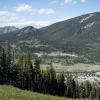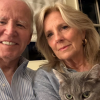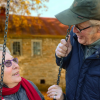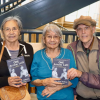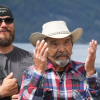At takliʕaickst (Slocan Lake), caylx (Richard Armstrong) walks over to a group of elementary students, shaking each child’s hand and thanking them for their help.
On Tuesday afternoon (May 13), the syilx Elder and knowledge keeper guided the children in the ceremonial release of 10,800 young salmon fry into the lake — part of an effort to bring the important fish back to upper part of nx̌ʷntk’ʷitkʷ (the Columbia River).
The students had raised the salmon themselves since January, part of the Okanagan Nation Alliance’s (ONA) Fish in Schools (FinS) program. As caylx sent the students back to their classrooms with warm smiles and messages of gratitude, the gleeful children exchanged a chorus of thank-yous.
Hundreds of classrooms across 64 schools in the Okanagan and Upper Columbia regions participated in the program this year. Between May 1 and 14, caylx led seven ceremonial releases into various waterways in syilx homelands, which began in snpinktn (Penticton) and ended in snkx̌ykntn (Revelstoke).
Their efforts are expected to see 5.35 million salmon fry released into the wild across syilx territories by the end of the school year.
(1).jpg)
Kids are ‘going to be the caretakers’
Since 2003, ONA has given participating schools fertilized salmon eggs and the equipment needed for students to raise the fish from egg to fry stage.
And around this time every year, the students then release the fish by hand into the Columbia River and its tributaries, during ceremonies throughout syilx homelands.
The annual program has acted as a key resource to educate young people about the importance of salmon for the ecosystem.
It’s also an opportunity for children to learn early in their lives about the species’ significance to the syilx people — in hopes they grow up to be advocates for salmon and their habitats.
“It’s so good to see all the school kids here, because … they’re going to be the caretakers of what’s happening today,” calyx said.
“When we’re no longer here, the responsibility is for them to continue this.”
Since he was 14, caylx has been helping to lead salmon ceremonies across his ancestral homelands.
His uncle had trained him in the role. Now, at 79, he’s preparing his nephew to take on the responsibility.
While caylx has no intentions of slowing down just yet, he’s spent the last 18 years training his nephew, nk’lxwcin (Chad Eneas), to take the role when his body no longer allows him to.
“He’s the one who’s going to be me when I can’t walk and do that anymore,” caylx said. “He knows how to do it now.
“When I’m gone, he’ll be teaching somebody, too — it’s carried on like that.”
caylx is a member of the Penticton Indian Band (PIB), and is of Sinixt (Arrow Lakes, Colville) ancestry through his mother. She grew up around sx̌ʷnitkʷ (Big Falls), also known as “Kettle Falls,” which feeds into the Columbia.
sx̌ʷnitkʷ was once an important fishing site for both the syilx and Sinixt people. calyx is a descendant of Kinkanaqua, who was the Salmon Chief for the Colville Tribes in the late 1800s.
“Because I have ancestry to Kinkanaqua, the responsibility was laid on me since I was 14 to do the salmon ceremony,” caylx told IndigiNews.
“It’s handed down from uncle to uncle to uncle. Even my name [caylx] is brought down. I carry the name that’s passed down for about four generations.”
He said a lot of his time is spent working with kids and students, “making them understand how important it is when we return little fish to the water.”
But he noted that the job is not just a matter of getting fish out of a tank and putting them into a lake or river.
“It’s understanding what that means to the land, to the air, to the people, to the water itself,” he explained.
He described how last year, scientists found salmon DNA from a valley’s lowest altitude near higher mountaintops in the region, providing nutrients to berry bushes to help them grow.
“Before science told me, my grandmother told me those berries at the top of the mountains are fertilized by the salmon in the river,” he said.
“The eagle takes them to the bank; the bear eats it and takes it further up the mountains; and the berries are fertilized.”
He plans on continuing to hold salmon-calling ceremonies later in June, including one at sx̌ʷnitkʷ, another ONA fisheries initiative.
Leading salmon ceremonies is an important responsibility to the land, water and tmixʷ (all living things), caylx said.
“It’s not something to brag about; it’s a responsibility that has to be done,” he said.
For nk’lxwcin, he shares a similar sentiment to his uncle and mentor, saying this work is far bigger than himself.
“It’s not about me, it’s about trying to carry on that tradition,” he said. “Connecting ourselves to our ancestors, to our ancestral lands — just trying to do the right thing.”
For now, nk’lxwcin is “just happy” he gets to help his uncle, “learning and trying to care for him” so he can continue his ceremonies and teachings as long as possible.
Salmon central to syilx teachings and values
For the syilx Okanagan Nation, salmon has been an integral food source and cultural figure for thousands of years.
Central to many of their captikʷł, the nation’s oral teachings and principles, salmon is one of the Four Food Chiefs — Chief ntytyix — who helped decide how the people-to-be would live and what they would eat.
Before colonization, the Columbia River was plentiful with fish — described by ONA as once being the greatest salmon-producing river system in the world.
In the late 1800s, European settlers began to overfish the river and its tributaries. Rapid settlement saw waterways straightened into channels and numerous dams built across the watershed, erasing salmon spawning habitats in the process and blocking ancient migration routes. As time went on, salmon stocks diminished in turn.
“Ninety per cent of the salmon populations have been wiped out, because 90 per cent of the habitat is gone,” said nk’lxwcin, a syilx traditional ecological knowledge co-ordinator at the En’owkin Centre.
“Those numbers go together.”
nk’lxwcin, a former chief of PIB, said working to heal relationships with the siwɬkʷ (water) — and between people — is crucial to restore both salmon populations and their habitats.
That’s why caylx’s ceremonial role is so important to bring those aspects together in prayer, nk’lxwcin explained.
“Because we used to go to jail for our prayers in this country,” nk’lxwcin said. “For 50 years, it was against the law for us to practice and to talk about who we are publicly.
“This is an opportunity to bring back some of those spiritual and cultural connections to who we are, and the land where we come from.”
Ceremony — drumming, prayers and other protocol — is essential in this work, caylx emphasized, because it allows the community to speak “the language that tmixʷ can hear.”
“It comes from the heart, not from words,” he said.
“That ceremony allows you to have the grasses, the trees, the breeze in the air, to understand your intention — intention of your heart; your feeling.”
He said that when Elders pray by the water during these ceremonies, they’re not just praying for the fish, but also for the water, the air, the sunshine, and the people.
“The prayer they say is not just to the Creator to ask him for help,” he said. “They’re telling the land, ‘We depend on you, be there for us.’ When the Creator made the land, he made the people.
“The land has to provide for us. May the land continue providing. That kind of thought is what the Elders talk about in their prayers.”
He explained that, during ceremonies, he’ll put water in his mouth and blow it out. He says the water droplets dissolve into the air, likening the process to condensation forming clouds in the sky.
“Your life force — your life essence — is for the trees to see,” he said. “It’s like a cloud coming through here. They can recognize what your heart feels like.
“When you do that, your life force is there for the trees to see who you are. That’s why that’s done — it puts your DNA out in the land.”
Efforts to raise and release salmon inspire Elders
At this year’s first FinS ceremonial release in snpinktn (Penticton) on May 1, nearly 1,000 attended, including more than 650 students, who released more than 3,000 fry into the wild — with the large attendance making it one of the largest ceremonial releases in the program’s history, according to ONA.
“All the little ones that are standing here from the schools touches my heart to see that,” calyx said. “I am so honoured to see that.”
He said releasing tiny juvenile salmon “small as one of your little fingers” into his nation’s waterways is particularly special when they later return larger and stronger.
“They are going to be big, strong,” he said. “When they go into the water, they remember the ancestry of their ancestry, that was here before we were here.”
One week later, during another ceremonial release at sənƛ̓uxuxtan (Six Mile Creek) in Okanagan Indian Band land, caylx danced and joked with Elder Pauline Gregoire-Archachan and her brother.
nk’lxwcin said it’s important for children to see that community interaction — Elders dancing, singing and laughing together.
“Even when you get old, you still have a purpose,” said nk’lxwcin. “We still have lots to learn from our Elders.”
While at sənƛ̓uxuxtan, calyx drummed and sang a Salmon Song — his own song about the sacred species — for the young people attending. He hopes all syilx children can one day learn the song, too.
“This song is the song about those little fish that we’re turning loose,” he said. “It talks about from the time they were eggs, to the time they get bigger, to the time that they jump at the falls.”
At the ceremony in snɬuxwqnm (Castlegar) on Tuesday, where 11,800 fry were released into the Columbia River, he told the crowd about a previous ceremonial release that “touched his heart.”
He said he’d watched a young girl speak to a salmon fry swimming in a cup she held in her hand, before she set it free in the river.
“I just happened to be standing beside her when I heard her talking to that fish that she raised,” he recalled.
“It touched my heart, how comforting that was to see — the kind of feeling that went with raising that little fish.”
He recounted how the girl told the fish, “Now you’re home. Now you’re back. Now you’re not in my home. You’re in your home.”
He said that it was his grandmother who shared with him that the language to speak to both salmon and the waters is the same, universal one.
"Your mom talked to you while you were in water,” he said, referring to the womb. “No matter what language it is from around the world, the mother can talk to the child in the water.
“Every one of us have that ability to do it.”
And at the ceremony at takliʕaickst on Tuesday, he addressed the children in nsyilxcən, which his nephew translated — explaining his uncle said it makes him “really happy” to see kids attending ceremonies for the salmon.
“When those salmon were little eggs, who took care of them?” he asked the children. “You guys took care of them until this point, and you’re going to turn them loose out into this water.”
He then told the students how the salmon fry would swim all the way to the ocean hundreds of kilometres away, where they’d live for four or five years.
“Then they’re going to come back,” he explained, “and they’re going to be really big.”
nk’lxwcin told the children there are people all along the Columbia River doing similar work to bring the salmon home, and that the species “need everybody’s help.”
“That’s why we’re doing this ceremony,” he said. “That’s really special for us for you guys to be here … And it’s your guys’ prayers that are going to be answered when those salmon come back.”
nk’lxwcin told the children to remember the day’s ceremony when they helped bring salmon back to their waters.
And he went on to encourage them to look out for previous years’ released salmon, finding their way back home.
“You guys remember this,” he said. “They should be starting to come back.”








(1).jpg)



